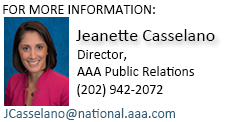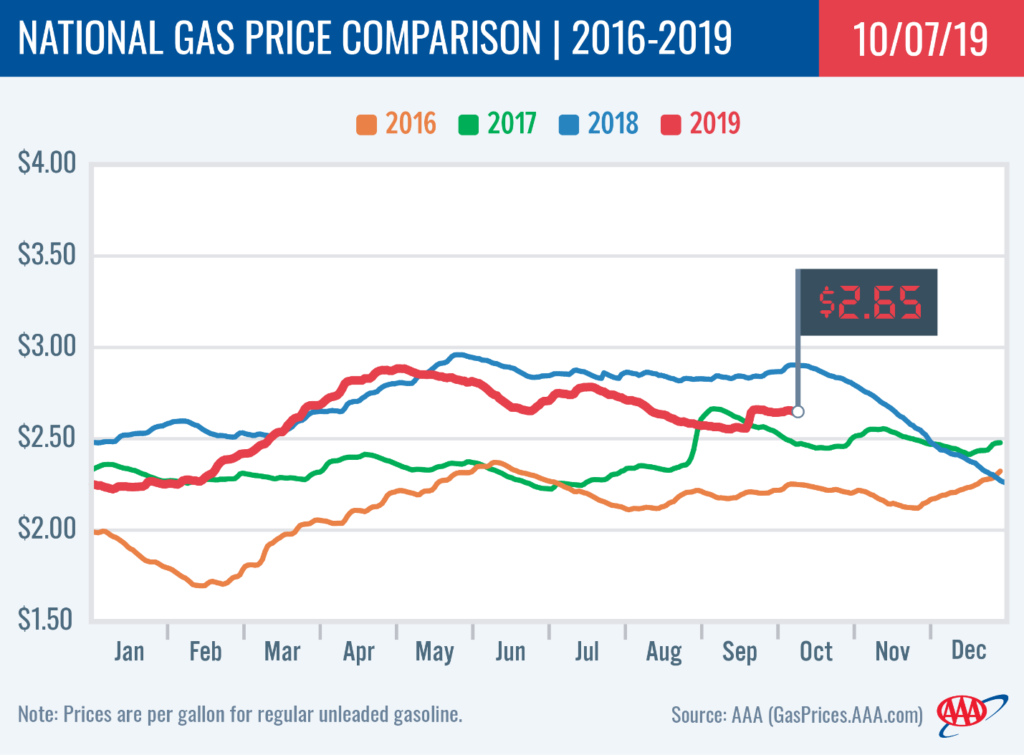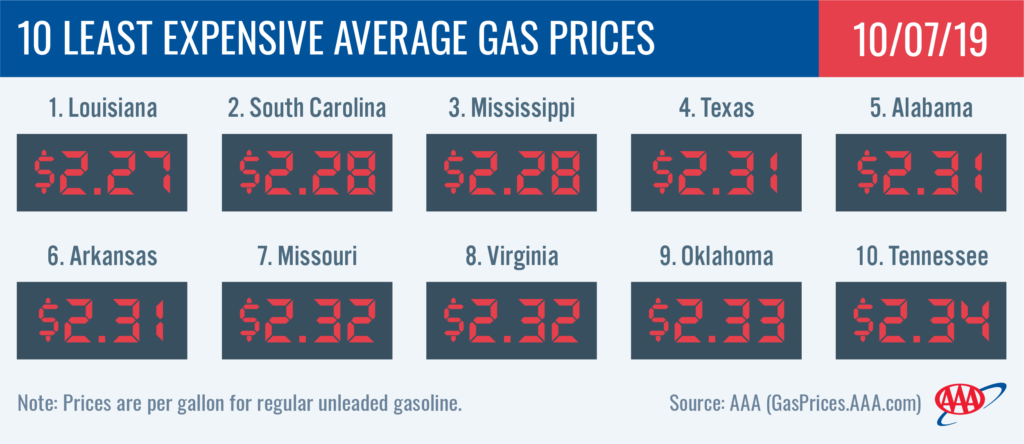[ad_1]

 The national gas price average continues to hold steady on the week at $2.65, which is nine cents more expensive than last month, but 26 cents cheaper than a year ago. Most motorists around the country are seeing prices decline or stabilize, with the majority of states seeing gas prices decrease by as much as a nickel since last Monday. But significant price jumps in California (+16 cents on the week) have pushed prices higher for motorists in the region, as gasoline stocks tighten along the West Coast.
The national gas price average continues to hold steady on the week at $2.65, which is nine cents more expensive than last month, but 26 cents cheaper than a year ago. Most motorists around the country are seeing prices decline or stabilize, with the majority of states seeing gas prices decrease by as much as a nickel since last Monday. But significant price jumps in California (+16 cents on the week) have pushed prices higher for motorists in the region, as gasoline stocks tighten along the West Coast.
“All regions are seeing planned and unplanned refinery maintenance, but it is only the West Coast that is really seeing gasoline stocks tighten and gas prices increase,” said Jeanette Casselano, AAA spokesperson. “On the whole, we are seeing gasoline demand mostly push lower amid stable, but healthy gasoline stock levels which are ultimately keeping prices cheaper for most motorists.”
Today, 51% of all gas stations in the country are selling regular unleaded for $2.50 or less, while 77% are selling for $2.75 or less.
Quick Stats
- The nation’s top 10 largest weekly changes are: California (+16 cents), Nevada (+14 cents), Indiana (-8 cents), Delaware (-8 cents), Michigan (+6 cents), Oregon (+6 cents), Washington (+5 cents), Georgia (-5 cents), Maryland (-4 cents) and Texas (-4 cents).
- The nation’s top 10 least expensive markets are: Louisiana ($2.27), South Carolina ($2.28), Mississippi ($2.28), Texas ($2.31), Alabama ($2.31), Arkansas ($2.31), Missouri ($2.32), Virginia ($2.32), Oklahoma ($2.33) and Tennessee ($2.34).
West Coast
Pump prices in the West Coast region have increased on the week, following a number of refinery outages that have tightened supply in the market. However, price increases have slowed as refineries work to resume production capacity. Assuming no additional outages, pump prices should stabilize toward the end of the week. California ($4.18) and Hawaii ($3.67) are the most expensive markets in the country. Nevada ($3.42), Washington ($3.28), Oregon ($3.16), Alaska ($2.95) and Arizona ($2.91) follow. California (+16 cents) saw the largest increase, followed by Nevada (+14 cents).
The Energy Information Administration’s (EIA) report, for the week ending on September 27, showed that total West Coast gasoline stocks decreased slightly from 27.1 million bbl to 27 million bbl. This level is approximately 900,000 bbl lower than this same time last year. Tighter supplies will continue to cause prices to spike, but as refineries resume normal gasoline production levels, pump prices are expected to stabilize.
Rockies
Motorists in the Rockies region continue to see little action at the pump with three state averages down on the week by one or two pennies: Utah ($2.78), Wyoming ($2.69) and Montana ($2.71). Idaho’s ($2.75) average held steady.
Both regional gasoline stocks and refinery utilization were relatively unchanged in EIA’s latest report. Gasoline stocks held at 7.7 million bbl while refinery dipped from 91.3% to 90.9%. The region could see some fluctuation should Rockies refineries be tapped to help back-fill tightening gasoline supplies in the West Coast region. The good news is gasoline stocks in the Rockies sit at the highest level of the year and show a year-over-year surplus, so any fluctuation should not be significant.
Great Lakes and Central States
Pump prices compared to a year ago are 20 cents to 45 cents cheaper for all motorists in the Great Lakes and Central states. Six states land on the top 10 list for largest yearly change: Indiana (-46 cents), Iowa (-45 cents), Nebraska (-39 cents), Kentucky (-39 cents), South Dakota (-39 cents), and Wisconsin (-39 cents).
On the week, all but three states in the region saw gas prices that are cheaper – by as much as four cents – or stable. Michigan (+6 cents), Ohio (+2 cents) and Illinois (+3 cents) were the outliers.
The region was just one of two to see gasoline stocks increase on the week. According to the latest EIA data, stocks built by nearly 1 million bbl to total 51 million bbl as regional refinery utilization held steady at 92%. The region is likely to see gas prices remain mostly stable or cheaper with the exception of typical volatility for a handful of states.
South and Southeast
Florida (+4 cents) was one of a handful of states east of the Mississippi to see gas prices jump on the week. All other states in the South and Southeast continued to see cheaper or stable pump prices with Georgia ($2.49), Texas ($2.31) and South Carolina ($2.28) seeing the largest decline of four cents.
Eight of the top 10 states with the cheapest averages in the country hail from the region: Louisiana ($2.27), South Carolina ($2.28), Mississippi ($2.28), Texas ($2.31), Alabama ($2.31), Arkansas ($2.31), Oklahoma ($2.33), and Tennessee ($2.34). Compared to a year ago, these state averages are at least 30 cents cheaper.
With a 1 million bbl draw, gasoline stocks dipped down to 79.3 million bbl. The drop in stocks can likely be attributed to an increase in exports and a dip in regional refinery utilization, which dropped by 4% to 88% – a regional rate not seen since March. The lower rate is due to planned and unplanned maintenance at refineries. However, with stocks at a healthy level, motorists are unlikely to see large swings at the pump.
Mid-Atlantic and Northeast
For another week, all states in the region saw pump prices push cheaper, with Delaware seeing the largest decline. In fact, Delaware (-8 cents) and Maryland (-4 cents) landed on the list of top-10 largest weekly declines. As state averages continue to decline in the region, not one state ranks among the top 10 most expensive in the country. Pennsylvania ($2.75) and New York ($2.71) rank as the 11th and 13th highest averages in the country and the most expensive in the region. Conversely, Virginia ($2.32) carries the cheapest average in the region.
For a second week, gasoline stocks increased by a moderate nearly 600,000 bbl to total 64.9 million bbl in EIA’s latest report. Regional refinery utilization dropped by another 1% down to 67%. It’s likely that motorists will see gas prices continue to decrease in the week ahead.
Oil market dynamics
At the close of Friday’s formal trading session on the NYMEX, WTI increased by 36 cents to settle at $52.81. Crude prices ended lower last week after continued trade tensions between the U.S. and China worried market observers. Those fears grew last week after the World Trade Organization ruled that the U.S. could impose tariffs on goods from the European Union. Increased tariffs could reduce global crude demand, helping to push prices down even further while crude supplies continue to increase. Moving into this week, further trade tensions could reduce crude prices amid worries that global crude demand will decline.
In related news, in its latest weekly report, EIA’s data revealed that total domestic crude inventories grew by 3.1 million bbl. At 422.6 million bbl, crude stocks are 18.7 million bbl higher than where they were at this time last year.
Motorists can find current gas prices along their route with the free AAA Mobile app for iPhone, iPad and Android. The app can also be used to map a route, find discounts, book a hotel and access AAA roadside assistance. Learn more at AAA.com/mobile.
[ad_2]
AAA Newsroom Source link











